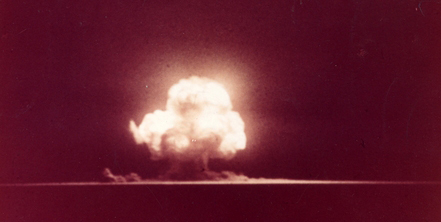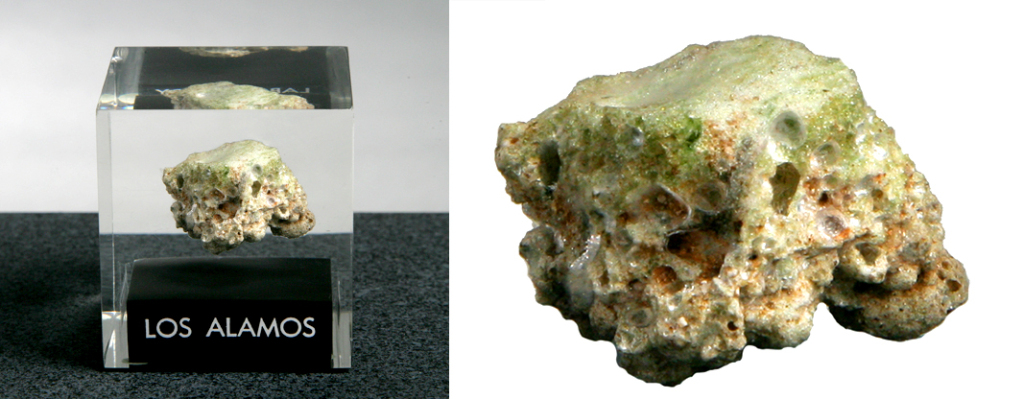WWII 75: Marching to Victory | July 16, 2020

WWII highlights from the Truman Library’s archives and collections
Marching to Victory: The Trinity Test
July 16, 1945
At 5:29 AM on July 16, 1945, an enormous explosion rocked the bleak desert of southern New Mexico. The cause of the blast was a device called the Gadget, which exploded with the force of forty million pounds of TNT. It produced intense heat, a light brighter than the sun, and a mushroom cloud 7.5 miles high that glowed yellow, then red, then purple. People felt the shockwave 100 miles from ground zero, and newspapers reported that a blind woman 150 miles away asked: “What’s that brilliant light?”
“That brilliant light” was the first detonation of a nuclear weapon; the test was given the code name “Trinity” by physicist J. Robert Oppenheimer after a poem by John Donne.
Twenty miles from the epicenter of the blast a small group of observers watched and listened in awe and then broke into cheers. Many had been working toward a successful explosion of atomic weapons since June of 1942, when the U.S. Army began the Manhattan Project, a massive yet secretive effort to harness the new science of atomic energy for Allied victory. Three years in, the Trinity Test was a stunning, deafening, scorching display of nuclear energy’s potential to win the war.
Although President Truman was unable to be at ground zero (he was in Potsdam, Germany, with Stalin and Churchill), the Truman Library’s collection includes a unique memento of the world’s first detonation of a nuclear bomb.
Nearly 26 years after Trinity, Winston Dabney, a member of the Los Alamos Veterans Reunion Committee, presented President Truman with a lump of glass from the testing site. This was not just any glass. The explosion’s heat (at least 2,678 degrees Fahrenheit at ground zero) melted and fused together the sand and bomb pieces that rained down, producing oddly beautiful bits of green glass. The material, called trinitite, is prized by collectors and was initially sold as jewelry – until it was pulled off the market when people realized the dangers of radiation.

Today, this piece of trinitite, which is encased in lucite and labeled “Los Alamos” for the location of the laboratory where scientists and soldiers worked on the weapon, serves as a reminder of Truman’s crucial role in Trinity and the dawning of the Atomic Age.
More to Explore
- Explore the Truman Library’s Atomic Bomb Collection.
- Relive history in The White House Decision Center. Step back to 1945 and into the roles of President Truman, J. Robert Oppenheimer and other West Wing advisors. How will WWII end? You decide.
Marching to Victory
75 years ago, World War II ended under President Truman’s decisive leadership. Now, follow key events from the war’s final months with the Truman Library Institute’s series, “Marching to Victory: WWII Highlights from the Truman Library’s Archives and Collections.” The 25-part blog series opens the vaults at Truman’s presidential library to share eyewitness accounts and historic artifacts related to major conflicts and monumental victories – from the Battle of the Bulge to the liberation of Dachau to the unconditional surrender of Japan.
More in this series:
Marching to Victory: The Bombing of Dresden
Marching to Victory: The Yalta Conference
Marching to Victory: The Battle of the Bulge
Marching to Victory: The Tokyo Fire Raids
Marching to Victory: The Battle of Okinawa
Marching to Victory: The Liberation of Buchenwald
Marching to Victory: “The President is Dead”
Marching to Victory: The Liberation of Dachau
Marching to Victory: The Death of Adolf Hitler
Marching to Victory: Germany Surrenders!
Marching to Victory: Victory Gardens
Marching to Victory: Civil Rights
Marching to Victory: The United Nations
Marching to Victory: How Children Helped Win the War
Contributed by Will Hickox, Ph.D. He has written for The New York Times and contributed to several digital history projects.
Join our email list to receive Truman updates right in your inbox:



